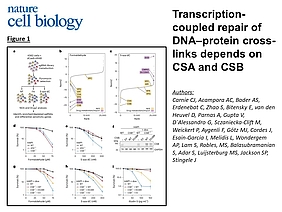New publication from the Stingele lab on the transcription-coupled repair of DNA–protein cross-links depends on CSA and CSB
Carnie CJ, Acampora AC, Bader AS, Erdenebat C, Zhao S, Bitensky E, van den Heuvel D, Parnas A, Gupta V, D´Alessandro G, Sczaniecka-Clift M, Weickert P, Aygenli F, Götz MJ, Cordes J, Esain-Garcia I, Melidis L, Wondergem AP, Lam S, Robles, MS, Balasubramanian S, Adar S, Luijsterburg MS, Jackson SP, Stingele J (2024) Transcription-coupled repair of DNA–protein cross-links depends on CSA and CSB. Nat Cell Biol., doi.org/10.1038/s41556-024-01391-1
Abstract:
Covalent DNA–protein cross-links (DPCs) are toxic DNA lesions that block replication and require repair by multiple pathways. Whether transcription blockage contributes to the toxicity of DPCs and how cells respond when RNA polymerases stall at DPCs is unknown. Here we find that DPC formation arrests transcription and induces ubiquitylation and degradation of RNA polymerase II. Using genetic screens and a method for the genome-wide mapping of DNA–protein adducts, DPC sequencing, we discover that Cockayne syndrome (CS) proteins CSB and CSA provide resistance to DPC-inducing agents by promoting DPC repair in actively transcribed genes. Consequently, CSB- or CSA-deficient cells fail to efficiently restart transcription after induction of DPCs. In contrast, nucleotide excision repair factors that act downstream of CSB and CSA at ultraviolet light-induced DNA lesions are dispensable. Our study describes a transcription-coupled DPC repair pathway and suggests that defects in this pathway may contribute to the unique neurological features of CS.
Read the full paper here: https://www.nature.com/articles/s41556-024-01391-1

